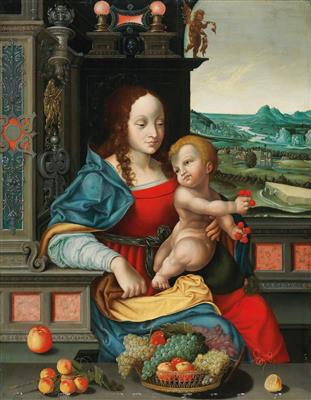Follower of Joos van Cleve

The Madonna of the Cherries,
oil on panel, 81.5 x 64.5 cm, framed
Provenance:
Collection of Dieter Klenk (1906–1983), Mainz, 1964;
where acquired by the present owner in 1983
The present lot depicts the Virgin and Child before an architectural setting after the antique, or as it was conversely known in the Renaissance, the modern style. As with all pictures of this type it is rapt with symbolic meaning, and is characteristic of the oeuvre of Joos van Cleve, one of the most important artists working in Antwerp during the early decades of the 16th Century. The Italianate setting is no coincidence, several artists executed compositions after this subject, which are suspected to derive from a lost work by Leonardo da Vinci.
The apple on the ledge on the bottom left of the picture is thought to refer to the Fall of Man. the cornfield being hoed in the background may refer to the body of Christ, celebrated in the eucharist. The peasants themselves may represent the ‘Miracle of the Corn.’ They allegedly told pursuing soldiers during the Holy Family’s Flight into Egypt that the corn had grown since the Holy Family had passed by, making the soldiers think the trail had gone cold, even though it had sprung up miraculously moments before. Equally the pagan statue perched precariously on the edge of ledge at the top of the composition would have been expected to fall with the coming reign of Christ. Finally, the cherries themselves in the hands of the infant Christ represent the fruits of paradise.
Specialist: Damian Brenninkmeyer
 Damian Brenninkmeyer
Damian Brenninkmeyer
+43 1 515 60 403
damian.brenninkmeyer@dorotheum.at
30.04.2019 - 17:00
- Estimate:
-
EUR 60,000.- to EUR 80,000.-
Follower of Joos van Cleve
The Madonna of the Cherries,
oil on panel, 81.5 x 64.5 cm, framed
Provenance:
Collection of Dieter Klenk (1906–1983), Mainz, 1964;
where acquired by the present owner in 1983
The present lot depicts the Virgin and Child before an architectural setting after the antique, or as it was conversely known in the Renaissance, the modern style. As with all pictures of this type it is rapt with symbolic meaning, and is characteristic of the oeuvre of Joos van Cleve, one of the most important artists working in Antwerp during the early decades of the 16th Century. The Italianate setting is no coincidence, several artists executed compositions after this subject, which are suspected to derive from a lost work by Leonardo da Vinci.
The apple on the ledge on the bottom left of the picture is thought to refer to the Fall of Man. the cornfield being hoed in the background may refer to the body of Christ, celebrated in the eucharist. The peasants themselves may represent the ‘Miracle of the Corn.’ They allegedly told pursuing soldiers during the Holy Family’s Flight into Egypt that the corn had grown since the Holy Family had passed by, making the soldiers think the trail had gone cold, even though it had sprung up miraculously moments before. Equally the pagan statue perched precariously on the edge of ledge at the top of the composition would have been expected to fall with the coming reign of Christ. Finally, the cherries themselves in the hands of the infant Christ represent the fruits of paradise.
Specialist: Damian Brenninkmeyer
 Damian Brenninkmeyer
Damian Brenninkmeyer
+43 1 515 60 403
damian.brenninkmeyer@dorotheum.at
|
Buyers hotline
Mon.-Fri.: 10.00am - 5.00pm
old.masters@dorotheum.at +43 1 515 60 403 |
| Auction: | Old Master Paintings |
| Auction type: | Saleroom auction |
| Date: | 30.04.2019 - 17:00 |
| Location: | Vienna | Palais Dorotheum |
| Exhibition: | 20.04. - 30.04.2019 |
